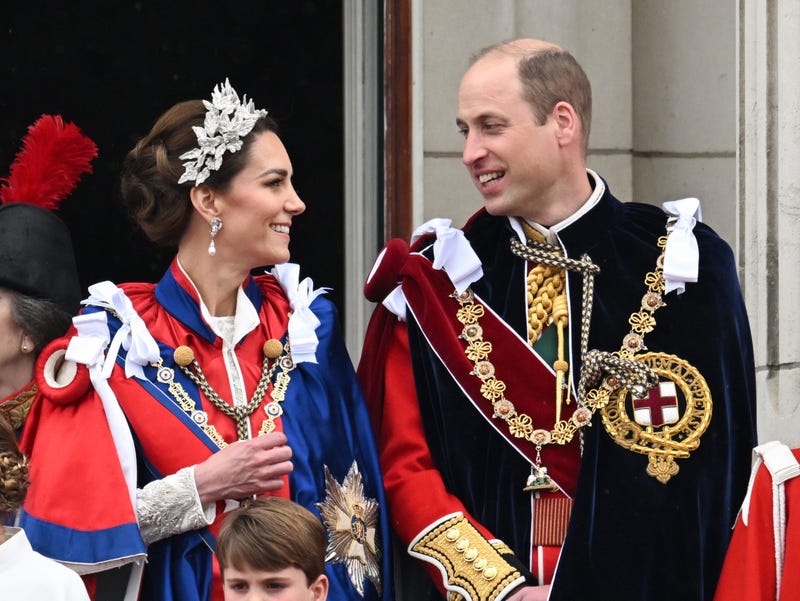Prince William and Princess Catherine are embarking on a transformative journey that could redefine the British monarchy’s future.
As they prepare for their eventual ascension to the roles of king and queen, their path has not been without its challenges.
Personal struggles, family dynamics, and an evolving royal landscape have all played a part in shaping their approach.
Yet, the couple remains resolute in their mission to modernize the monarchy, moving away from age-old traditions in favor of a more contemporary framework.
The couple’s recent activities have ignited conversations, especially amidst ongoing speculation regarding King Charles‘s potential abdication.
Now in their forties, both royals seem poised to instigate significant cultural shifts within the monarchy.
The grandeur and opulence that characterized past reigns might soon be replaced with a more relatable and accessible royal presence.
William and Catherine are already stepping beyond the confines of palace life.
Their vision for the future is clear: they intend to lead a royal family that emphasizes meaningful ceremonies and traditions while eschewing the extravagant displays that have long been associated with the crown.
This marks a significant departure from the historical norms, as they take proactive steps to modernize royal operations even before officially taking up their future roles.
One notable change includes the appointment of a former Tesco CEO to manage their royal foundation, signaling a pivot toward a more corporate-style structure.
This move suggests that the Waleses are serious about running their royal duties with efficiency and professionalism, setting a new tone for how the monarchy operates behind the scenes.
In addition to restructuring their foundation, William and Catherine are also rethinking the management of their private office.
They aim for a more hands-on approach, bypassing traditional palace hierarchies and advisors.
This shift comes as many younger royals express discontent with the influence of courtiers—those who have historically advised the monarchy on various matters.
The late Princess Diana was one of the first to voice concerns over the role of courtiers in royal affairs.
Her son, Prince Harry, echoed these sentiments, criticizing the entrenched power held by older advisers.
William appears to share these concerns and is reportedly committed to challenging this outdated system once he takes the throne.
Royal expert Richard Eden has pointed out that William’s ambitions for the monarchy are both bold and far-reaching.
A friend of the prince revealed that William is acutely aware of the monarchy’s future and is determined to make it more relevant to contemporary society.
This likely means a reduction in the pomp and ceremony that have long defined royal life.
Already, signs of this new direction are emerging.
A significant change has been the scaling back of traditional balcony appearances during Trooping the Colour, a royal event steeped in spectacle.
Since Queen Elizabeth II’s passing, fewer royals have participated, and this trend is expected to continue under William’s leadership.
He has indicated that, once older royals retire, he won’t invite new members to join the working royal roster.
The British monarchy, once synonymous with medieval rituals and grandeur, is on the brink of substantial transformation.
As other European monarchies have downsized and adapted to modern expectations, so too is the British royal family.
While the extent of these changes remains uncertain, it’s evident that a shift is underway.
Moreover, William and Catherine are dedicated to providing their children—Prince George, Princess Charlotte, and Prince Louis—with a more typical upbringing, despite their royal lineage.
This approach reflects their desire to maintain a sense of normalcy in their children’s lives, contrasting sharply with the experiences of previous generations.
This evolution in the royal family coincides with growing concerns about King Charles’s health.
As the King undergoes cancer treatment, he has had to scale back his public engagements, allowing William to step into a more prominent role.
This changing dynamic has not gone unnoticed, with many observing William’s increasing responsibilities within the monarchy.
A pivotal moment in this transition occurred when William represented the royal family at the reopening of Notre Dame Cathedral in Paris.
His presence underscored his growing importance as a royal representative, particularly in light of King Charles’s absence.
As the Waleses continue to navigate their family life and royal duties, they are gradually preparing for the future that awaits them.
The British monarchy is undeniably on a path of change, with William and Catherine at the forefront of this transformation.
Their commitment to modernizing the institution, streamlining royal responsibilities, and fostering a more relatable lifestyle for their children signals a new era—one that prioritizes practicality, modernity, and a genuine connection with the public.
Related Stories

